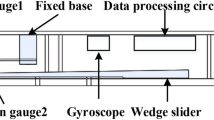Abstract
Traditional isolator is hard to control because that it is easily caused large deformation by middle and above earthquake force, resulting in the large transmission of seismic force to structure. Therefore, Bi-Tilt Isolator, BTI is developed to improve the defects of isolator. BTI is composed of symmetrical slope, sliding force will not occur when the interactive force is less than threshold value. To investigate the dynamic responses and influences of this proposed BTI, Arduino techniques is applied to develop a smart measuring device for measuring acceleration responses. Then, a no-contact low-cost accuracy detecting method-dynamic digital image correlation method, DIC is proposed to detect the displacement responses and analyze influence of BTI. Mathematical models and const velocity regression method are derived to simulate the dynamic responses of this proposed BTI based on the motion stages of BTI. Then, dynamic test and numerical analysis results of BTI are compared to demonstrate the accuracy of these proposed models. Analysis results reveal that (1) this developed smart measuring device is easily to detect the acceleration responses of BTI based on Arduino techniques; (2) displacement responses also tiny displacement responses of BTI are easily identified by the Dynamic DIC method; (3) the proposed mathematical model and constant velocity regression method can simulate accurately dynamic responses in the interface between substrate of BTI and slider with fully lubricated and mild lubrication. For those without lubrication, the analysis accuracy of error root mean square attains 0.42% and 3.10% of initial displacement for nonlinear and constant friction respectively.











Similar content being viewed by others
References
Robinson W H 1982 Lead-rubber Hysteretic Bearings Suitable for Protecting Structures During Earthquakes; Earthq. Eng. Struct. Dyn. 10: 593–604
Matsagar V A and Jangid R S 2004 Influence of isolator characteristics on the response of base-isolated structures; Eng. Struct. 26(12): 1735–1749
Jangid R S 2007 Optimum lead–rubber isolation bearings for near-fault motions; Eng. Struct. 29(10): 2503–2513
Salic R B, Garevski M A and Milutinovic Z V 2008 Response of Lead-Rubber Bearing Isolated Structure. The 14th World Conference on Earthquake Engineering, Beijing, China.
Bridget Cunningham 2015 Using Lead Rubber Bearings in Base Isolation Systems, https://www.comsol.com/blogs/using-lead-rubber-bearings-in-base-isolation-systems/
Hanson R 2016 Earthquakes and the benefits of lead rubber bearing base isolation, http://www.stuff.co.nz/science/87075507/Roger-Hanson-Earthquakes-and-the-benefits-of-lead-rubber-bearing-base-isolation
Mishra P and Awchat G D 2017 Lead Rubber Bearings as Base Isolating Devices for the Construction of Earthquake Resistant Structures-A Review; SSRG Int. J. Civ. Eng. 4(7): 18–20
Kelly J M 1993 Earthquake-Resistant Design with Rubber; Springer, USA
Tian X M and Lu M 2008 Design of Base-Isolated Structure with Rubber-Bearing. The 14th World Conference on Earthquake Engineering, Beijing, China.
http://www.bridgestone.com/products/diversified/antiseismic_rubber/structure.html
Chirez S, Fujits S, and Minagawa K 2014 Effect of Nonlinearity of Rubber Bearing on a Seismic Isolated Structure Considering Their Layout, ASME 2014 Pressure Vessels and Piping Conference; Anaheim, California, USA
Sponagle N C and Atherton D L 2008 Optimized linear variable differential transformer displacement transducer for cryogenic use; Rev. Sci. Instrum. 51(6): 759. https://doi.org/10.1063/1.1136307
Anandan N and George B 2017 Design and Development of a Planar Linear Variable Differential Transformer for Displacement Sensing; IEEE Sens. J. 17(16): 5298–5305
Displacement and Position Sensing, Measurement Computing, U.S.A. info@mccdaq.com • mccdaq.com.
Omirou S 2018 Displacement Sensors Displacement Sensors-Potentiometer. The Linear and Rotary Potentiometer - AMEM 211.
Shih M H and Sung W P 2019 Developing Smart Measurement Device to Measure Kinetic Friction Coefficients of Bi-Tilt Isolator, Advances in Civil Engineering 2019 Article ID 4392506, 12 pages. https://doi.org/10.1155/2019/4392506
Shih M H and Sung W P 2014 Developing Dynamic Digital Image Correlation Technique to Monitor Structural Damage of Old Buildings under External Excitation, Shock and Vibration 2014, Article ID 954840, 15 pages. https://doi.org/10.1155/2014/954840.
Tung S H, Shih M H and Sung W P 2014 Applying the Digital-Image-Correlation Technique to Measure the Deformation of an Old Building’s Column Retrofitted with Steel Plate in an In-situ Pushover Test; Sadhana—Acad. Proc. Eng. Sci. 39(3): 699–711
Shih M H and Sung W P 2018 Experimental Validation of Numerical Model for Bi-Tilt-Isolator, Shock and Vibration 2018 Article ID 7163516, 12 pages https://doi.org/https://doi.org/10.1155/2018/7163516
Acknowledgement
The authors would like to acknowledge the support of Taiwan Ministry of Science and Technology through grant No. MOST-105-2221-E-260-003 and MOST-105-2221-E-167-001.
Author information
Authors and Affiliations
Corresponding author
Rights and permissions
About this article
Cite this article
Shih, MH., Sung, WP. Developing experimental technology and numerical analysis model for non-linear behaviour of Bi-tilt isolator. Sādhanā 46, 96 (2021). https://doi.org/10.1007/s12046-021-01600-9
Received:
Revised:
Accepted:
Published:
DOI: https://doi.org/10.1007/s12046-021-01600-9




